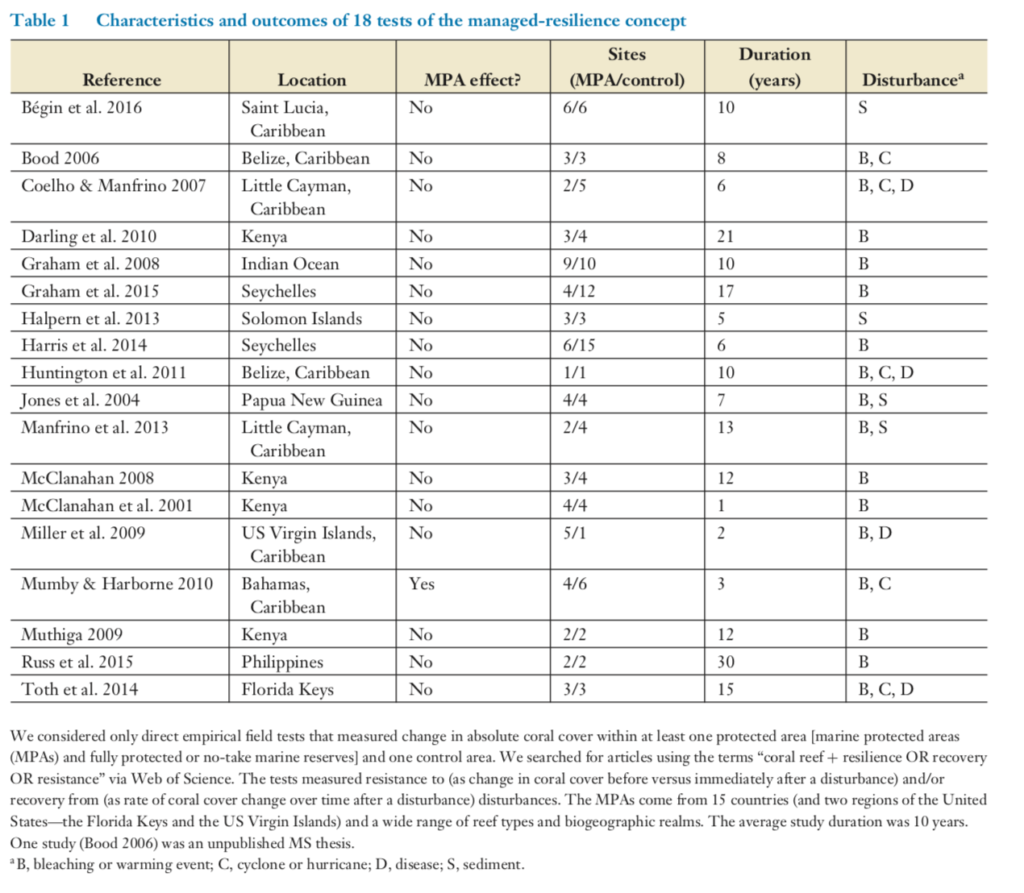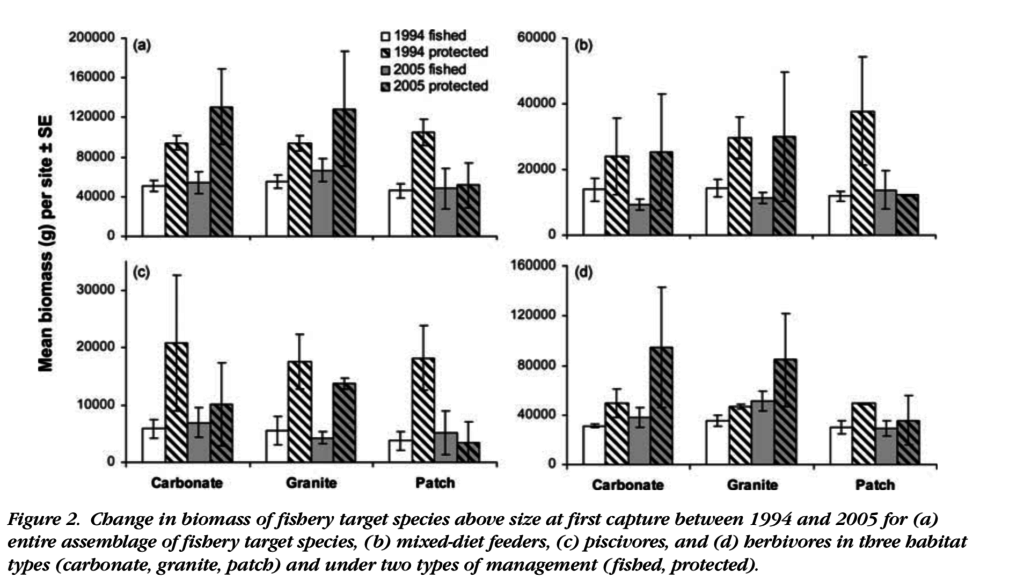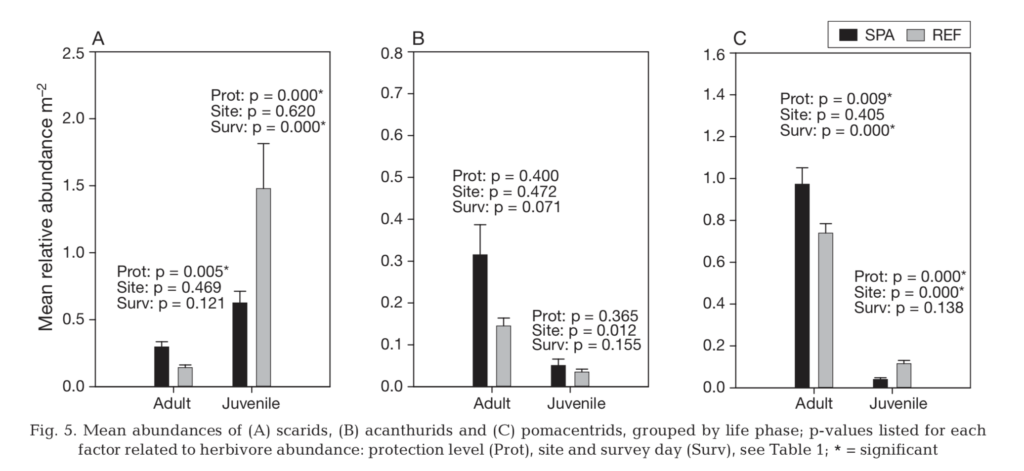One question I’ve gotten recently after presenting the results of the primary meta-analysis in this paper is whether the MPAs (most of which are fully protected marine reserves) were effective in protecting fish populations. Are they well-designed, well-enforced, etc. and are there more fishes, particularly herbivorous fishes, inside them than in neighboring unprotected sites?
It’s a fair question and one we talked about extensively at several stages of the study. That an MPA was proven effective in terms of fish conservation was not a criteria for inclusion in the study. But I was aware that nearly all the component studies were based on MPAs that did indeed have greater fish biomass. And also that some were clearly ineffective, whether due to size, age, isolation or any of the NEOLI features of Edgar et al. 2014.
The primary finding was that protection did not affect the resistance or recovery of the coral community (in terms of total live cover) in response to large scale disturbances, i.e., storms, bleaching and disease.

This meta-analysis was based on 18 studies that included 66 MPAs and 89 unprotected control sites:

For each study, are the protected sites believed or shown to be effective in protecting fishes, particularly herbivorous fishes?
Bégin et al., 2016 Yes
The cover of all benthic biotic components has changed significantly over the decade, including a decline in coral and increase in macroalgae. Protection status was not a significant predictor of either current benthic composition or changes in composition.
A series of small no-take MPAs, known as the Soufriere Marine Management Area (SMMA), was created in 1995 on the west coast of the island. These MPAs have had a high level of compliance [28, 29], and within six years of estab- lishment, total biomass of fishes had quadrupled inside the reserves and tripled outside the reserves, with the greatest increase observed for herbivores [30]. Greater biomass of herbivorous fish inside the SMMA compared to adjacent sites was observed again in early 2014 (R. Steneck, personal communication). However, the initial benefits of the SMMA did not extend to coral, which decreased in cover by 35–46% over this 6-year period, owing to disease (in 1997), bleaching (in 1998), hurricane damage (in 1999), as well as chronic sedimentation stress from the Soufriere River [31–34].
28. Burke L, Greenhalgh S, Prager D, Cooper E. Coastal Capital—Economic Valuation of Coral Reefs in Tobago and St. Lucia. World Resources Institute, 2008.
29. Roberts CM, Bohnsack JA, Gell F, Hawkins JP, Goodridge R. Effects of marine reserves on adjacent fisheries. Science. 2001; 294(5548):1920–3. PMID: 11729316
30. Hawkins JP, Roberts CM, Dytham C, Schelten C, Nugues MM. Effects of habitat characteristics and sedimentation on performance of marine reserves in St. Lucia. Biological Conservation. 2006; 127 (4):487–99. PMID: ISI:000234960900012.
Bood, 2006 No via Cox et al. 2017:

Coelho and Manfrino, 2007 YES via Dromard et al 2011
Darling et al., 2010 Yes
Seven sites were located on intensively fished reefs (Diani, two sites; Kanamai, two sites; Ras Iwatine, one site; Vipingo, two sites) and five sites were located on reefs inside unfished, no-take marine re- serves (Malindi Marine National Park, two sites; Mombasa Marine National Park, two sites; Watamu Marine National Park, one site); fished and unfished sites are interspersed along the coast (for map, see McClanahan & Obura 1995). Fishing prohibition is enforced in all Marine National Parks while artisanal fishers intensively exploit the nonpark reef sites (McClanahan et al. 2008).
McClanahan, T.R., Obura D. (1995) Status of Kenyan coral reefs. Coast Manage 23, 57–76.
McClanahan, T.R., Hicks C.C., Darling E.S. (2008) Malthusian overfishing and efforts to overcome it on Kenyan coral reefs. Ecol Appl 18, 1516–1529.
Graham et al., 2008 and 2015: Yes, eg via Graham et al 2007

Halpern et al., 2013 No
Harris et al., 2014 Yes
Huntington et al., 2011 No
Jones et al., 2004 Somewhat…
Manfrino et al., 2013 Yes via Dromard et al 2011:

McClanahan, 2008 Yes
Mcclanahan et al., 2001 Yes
Miller et al., 2009 No (based on personal comm. and no evidence to the contrary that I can find)
Mumby and Harborne, 2010 Yes
Muthiga, 2009 Yes:

Russ, 2015 Yes
Toth et al., 2014 Yes via Kramer and Heck, 2007

So in summary, most the MPAs in the study are effective in protecting fishes: 12 of the 18 studies included such MPAs. I don’t see it as a design flaw that some are not. First, that’s just the reality. In fact; it’s the norm. Second, had there been an effect of protection on coral resilience, it would have been useful to try to assess why, e.g., due to the enforcement.
Leave a Reply